by Mark Van Proyen

This exhibition offers a choice (albeit abbreviated) selection of works that span the entire careers of two American figurative painters, each of whom, in their own way, bucked the prevailing trend of Abstract Expressionism during the late 1940s and throughout the 1950s. Their similarities are easy to spot—both used a loose painterly technique to render the figure in either landscape or domestic scenes, and both used stunningly idiosyncratic colors. Each looked to aspects of European Modernism for inspiration and for standards by which they could evaluate the success of their own work, recoiling from the Dadaist and Surrealist orientations that were also manifesting themselves during the same period. Most importantly, each was a painter’s painter, a fact that once meant something important and now seems to again loom large given that the art world spotlight is warming to the work of a younger generation of figurative painters. In plainer words, we can say that the works of both of these artists can provide useful models for how painterly figuration can continue to be repurposed for our own changing times.
This is the second exhibition to pair these two artists’ works; the first was hosted by the same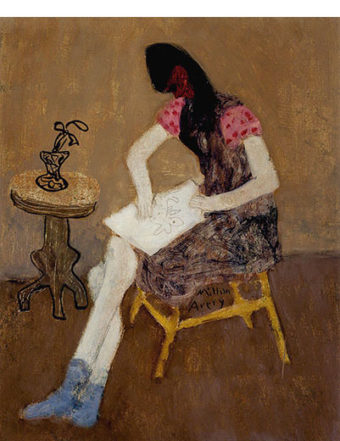
Avery was born 13 years earlier and lived five year longer than Park . Even though he was too young to be considered a member of the original Armory Show generation, by the end of the 1930s his work was fully saturated with European influences, even as it also gradually positioned itself in self-conscious opposition to the ambitions of the Ash Can school and Precisionist groups of the 1920s, and also the rural Regionalist movement of the 1930s. The earliest of his works on view here, March Sketching (The Artist’s Daughter) (1940-45), sets the stage. It is a small and charming work depicting its full-figure subject as an awkward adolescent working on a drawing while perched on an equally awkward chair that seems less than stable. To the left of the centrally placed figure, we see a Picassoid table supporting a wilted potted plant. The girl’s face is covered by her flowing dark hair, which makes her seem as if she wants to avoid eye contact with the viewer. Excepting her pink and magenta blouse and the yellow legs of the chair, the work is a study in soft rusty browns applied with an understated touch.
Reader in the Quarry (1947) shows Avery breaking through to his mature style. The scene takes place in late autumn, after the tree leaves have fallen and before the first snow. For the most part, the paint is thin, but not so much as be sketchy. Chromatic spice is added by the
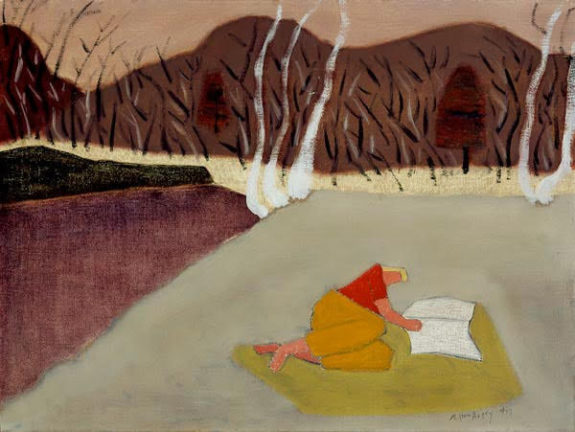
actual rendering of the androgynous figure wearing a red shirt and billowing orange pants, lounging atop a green blanket while pouring over the pages of what seems to be a newspaper. The small size of the figure in relation to the overall picture suggests an affinity with Asian painting, but the biographical record does not mention Avery having any special interest in or deep exposure to works hailing from that tradition.
There is a delightful compositional subtlety to be found in a work from 1948, Women Playing Cards. As is the case with March Sketching, faces are obscured, but we can infer much about the game from the body language of the two figures, one dressed in an ebullient yellow and the other shrouded dark red. The chairs upon which they sit seem every bit as animated as they are, and their convolutions make for a crisp and activated composition.
The earliest work in the show is a painting by Park from the md-1930s called Self-Portrait of the Artist Painting his Wife. Presumably the artist was in his mid 20’s when he painted the work, and it shows some influences of post-Cubist Neo-Classicism that he may have picked up 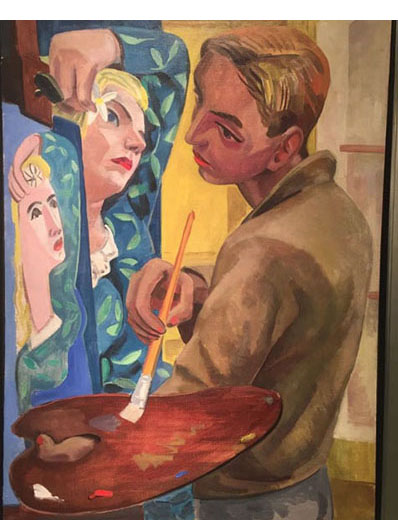
Pride of place in this exhibition’s installation is given over to a large work by Park titled Beach Scene (1952-55). It features four figures occupying very different spatial registers, one being only a head located in the work’s foreground, with another situated in the middle ground and a full figure in a candy-cane bathing suit standing at water’s edge on a curved beach that looks like an isolated cove. This work is a great example of Park’s breakthrough period, which started around 1950. That year corresponds to the time when Max Beckman was a distinguished visiting artist at Mills College, a visitation that was celebrated by two major exhibitions in 1950-51, one at Mills and the other at the SF MOMA. Is there a connection? Actually, it is hard to say,
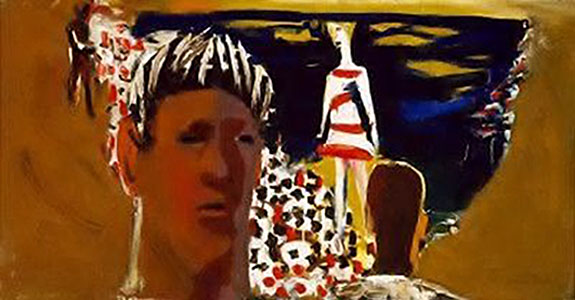
because the earliest example of Park’s much discussed “return to figuration” is Rehearsal
(1949-50), on loan from the Oakland Museum. Nonetheless, there are some stylistic parallels that should be considered, the use of a heavy dark outline to describe chiseled figures being the most salient. A glance at the big picture will also remind us that, in that Korean War/Joseph McCarthy moment, both Jackson Pollock and Willem de Kooning also “returned” to figurative subject matter, making Avery’s longstanding refusal to jump on the abstraction bandwagon seem ahead of, rather than behind his own moment.
As Park’s work developed through the mid-1950s to the end of the decade, he became ever more adventurous with color, substituting tonality with improbable hues and attacking the canvas evermore aggressively. There are two small oil works from that period, and both are stunning. I was particularly taken with Red Man in a Stripped Shirt (1959), a portrait head 
During the early phase of his career, Jackson Pollock thought himself to be “wrestling with Picasso,” only to find that every time he thought that he had scored anything resembling a triumph, it turned out that Picasso had already accomplished the same thing years earlier. Is it now possible to discern any similar wrestling contest going on between Avery and Park? Maybe, but perhaps dancing is the more accurate term for the way that each artist integrates their influential precedents. This is certainly true in the case of Avery’s “Americanization” of Matisse. His sense of decisive contour and perfectly modulated color certainly uphold the lessons that can be taken from the French master, but the perfectly imperfect ungainliness of Avery’s figures seem to be one of the important points of departure, reflecting, perhaps, his own very different, less sun-drenched environment. Like Matisse, Avery makes the accomplishment of pictorial perfection look much easier than it is, although he does this with more rectitude and less ebullience than we so frequently see in the French master’s work. Maybe a follow-up exhibition paring Avery’s work with that of Philip Guston could have a similarly eye-opening effect.
In the case of Park, the art historical dance partners are more varied. He starts with Picasso, moves on to the late work of Max Beckman and then does his best work in terse alignment with Cezanne’s late Bathersseasoned with the remorseless ruggedness of the work of his old 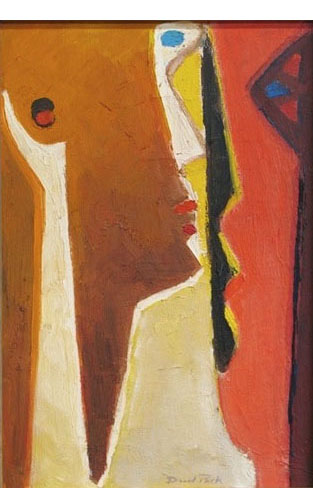
Casting these historical dance metaphors aside, we can still see another set of opposed terms that can help us see the Avery-Park comparison in a clearer light. Here, I refer to the distinction made by Adrian Stokes (in 1950) between “painters of a modeling proclivity” and others of a carving proclivity, with the former group adhering to the idea of the image as a “layered augmentation” of a surface, while the later excavating form from a surface as if it was carved from wet stone.1It is easy to see Park’s work as an exemplification of the carving of an image from the fleshy layers of paint, because each painting looks like the hard-earned result of a fraught contest. But seeing Avery’s work as “modeling” is more of a stretch, although not an impossible one. I say this because of the fact that Avery’s work always gets it right the first time, which might make his work look thin, sketchy and a bit frivolous to some people. But to them I would say, getting it right is no small feat, whether or not the path to arriving at that point indicates signs of visible struggle.
# # #
David Park & Milton Avery @ Hackett Mill through May 31, 2018.
1. Adrian Stokes, “ Carving and Modeling,” (1950) in The Image in Form: Selected Writings of Adrian Stokes,edited by Richard Wollheim (New York: Harper and Row, 1972). 47-48.
About the Author:
Mark Van Proyen’s visual work and written commentaries focus on satirizing the tragic consequences of blind faith placed in economies of narcissistic reward. Since 2003, he has been a corresponding editor for Art in America. His recent publications include: Facing Innocence: The Art of Gottfried Helnwein (2011) and Cirian Logic and the Painting of Preconstruction (2010). To learn more about Mark Van Proyen, read Alex Mak's December 9, 2014 interview, published on Broke Ass Stuart's Goddamn Website.